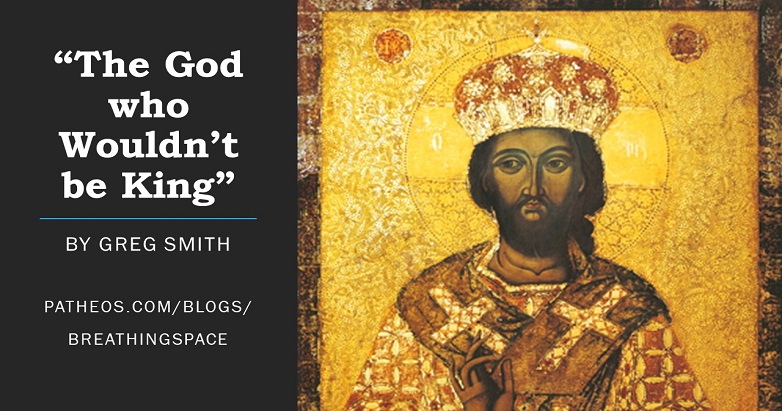The world watches in horror as Vladimir Putin invades Ukraine and slaughters his enemies. Are Christians to believe that Jesus wants to do the same?

Conquering King
The Book of Revelation ends with King Jesus returning on a white stallion. Clad in a robe dipped in blood, he terrifies the nations with eyes of fire. He defeats them with a sword from his mouth, and rules them with a rod of iron. On his robe and tattooed on his thigh are “King of kings and Lord of Lords.” He throws the beast and false prophet into the lake of fire and kills their armies with the sword of Jesus’ mouth. Unlike the month of March, which comes in like a lion and goes out like a lamb, in the book of Revelation, we start with the lamb that was slain and finish with the victorious lion.
Except–this violent King goes against every image the Gospels ever give us of Christ. I grew up hearing that with the first advent, Jesus demonstrated the love and grace of God, but with the second coming, Jesus would show God’s wrath against sin. I accepted that explanation for years, until I realized that it fundamentally misunderstands who Jesus is.
The God Who Wouldn’t be King
Repeatedly, Jesus shows that he is the God who wouldn’t be king. He doesn’t want an earthly throne.
- Luke’s gospel begins with Christ coming into the world, not in a king’s palace, but in a stable. The author contrasts the gentleness and humility of the babe and holy family with the ruthlessness of Herod’s reign.
- When Satan tempts Jesus in Matthew 4, the devil offers him all the kingdoms of the world—and Jesus turns down the offer.
- Matthew 14 depicts Herod and his royal family murdering John the Baptizer. Jesus was almost slain by one king, and his cousin was killed by another. Certainly, he wanted nothing to do with this kind of power.
- In John 6, after the crowds enjoy Jesus’ multiplying of loaves and fish, they try to force him to be king. But instead, he slips away from them.
- In the story of Jesus’ entry into Jerusalem (Matthew 21; Mark 11; Luke 19; John 12), Jesus does not stop the people from shouting, “Hosanna (Lord, save us)! Blessed is he who comes in the name of the Lord.” We call it “the triumphal entry,” and certainly there is Davidic imagery. Yet Jesus rejects pictures of powerful earthly kingship and triumph, choosing the humility of a donkey instead of the grandeur of a warhorse.
- Matthew 26 shows Jesus arrested. Peter tries to defend him, but Jesus tells the disciple to put away his sword. He reminds Peter that if he wanted, he could call legions of angels to fight for him. The power of kingship is at his disposal, yet he refuses it—even to save his own life.
- In John 18, Pilate puts Jesus on trial. Jesus insists that his kingdom is not of this world. If it were, he said his servants would fight for him.
We Don’t Need Another Hero
For some reason, we like the idea that Jesus who came first in peace will return to wage war in the end. Many Christians who claim to follow the Way of Jesus prefer to ignore his teachings like “love your enemies” and “turn the other cheek.” Wanting to create God in our own warlike image, we’d rather repaint Jesus as a violent conqueror than change our behavior to become more like the peaceful Christ. It’s unthinkable that the Lamb of God that we meet in the Gospels would completely change his personality in Revelation.
That’s why the only explanation for this is metaphor. Jesus is the God who wouldn’t be king. Violent imagery in Revelation is just that—imagery. Jesus is the perfect example of the phrase, “Love conquers all.” His eyes burn with love. His robes are dipped in his own blood—not that of his enemies. The sword from his mouth is the word of truth. If he kills, it’s sin that he slays. Jesus knows that we don’t need another hero—we need the Prince of Peace. He doesn’t need power—he doesn’t even want the throne.
Jesus Gives Up the Throne
In Revelation 20:4, Jesus shows the ultimate humility. Instead of plopping down on the throne himself, Jesus gives up the throne so that others may rule.
Then I saw thrones, and those seated on them were given authority to judge. I also saw the souls of those who had been beheaded for their testimony to Jesus and for the word of God. They had not worshiped the beast or its image and had not received its mark on their foreheads or their hands. They came to life and reigned with Christ a thousand years.
Some say that the Millennium has been taking place since the beginning of Christian history. Others who look to a future unfolding of the Millennium see it as a literal thousand-year period. Still other futurists look toward an actual thousand-year reign of Christ but maintain that this is a symbolic number. Personally, I don’t think it matters much. The important thing isn’t that Jesus reigns, but that he sets the ultimate example by helping others onto their thrones. The Millennium isn’t about Jesus ruling on earth—he showed already that he’s more interested in kinship than kingship, in kin-dom instead of kingdom. The Prince of Peace is humble enough to wash his disciples’ feet and then help them to reign.
If Jesus returns to wipe out his enemies, he’ll be no different from any other invading dictator. The world has enough conquering rulers. It isn’t remarkable if God reigns in the end. What’s impressive is that God shares the throne. And that’s a revelation, indeed!














